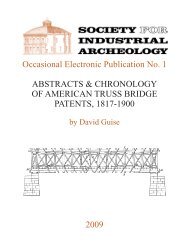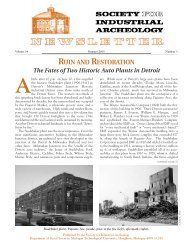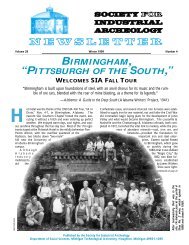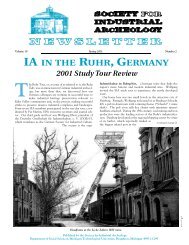SIAN - Society for Industrial Archeology
SIAN - Society for Industrial Archeology
SIAN - Society for Industrial Archeology
Create successful ePaper yourself
Turn your PDF publications into a flip-book with our unique Google optimized e-Paper software.
into his heavy boots. His left hand rests on the handle of apick, while his right firmly grasps a piece of ore. His barehead is thrown back, his chin up-tilted, and his face seriousas he gazes towards the mountains that would yield him his<strong>for</strong>tune. Borglum has shown Mackay as an image of vigorousmasculinity in his early <strong>for</strong>ties, conveying the strength,resolve, and hard work that would make him a wealthyman.A history of the Comstock Lode originally published in1943 characterized Mackay as a model benevolent capitalist:“His name was constantly on the people’s lips—almostinvariably with words of praise. Everything about him wasdistinctive; his modesty, his reserve, his unfailing kindnessto old friends, his innumerable benefactions, his uprightness,and the simplicity and decency of his life. Riches didnot corrupt or steal away his good name, but rather servedas his means to further develop American resources.” Hischaracter was “as clear as the lines of the WashingtonMonument.” Such hagiography was grounded in the beliefthat money earned through hard work denoted integrity ofcharacter. Borglum’s monument exemplifies Progressive Eraconfidence in modern economic development, and remainsa testament to a visionary man who became a legend in thehistory of mining in the rugged and remote “Silver State.”Betsy FahlmanSanta Cruz Portland Cement Co. #2Preservation & Experimental IAIn 1909, a 45-ton Porter 0-4-0T steam locomotive wasmanufactured <strong>for</strong> the Santa Cruz Portland Cement Co. <strong>for</strong>their quarry located in Davenport, CA. This locomotivewas a sizeable, oil-fired, saddle-tank engine equipped withslide valves and Stephenson link valve gear. It was useduntil 1924, when it was sold to the Betchell Kaiser RockCo. of Oroville. Later it was retired and eventually sold toRay Pollard in 1967 to be used as roadside advertising at thePollardville Amusement Center located on Highway 99 justnorth of Stockton.The locomotive remained at Pollardville, slowly deterioratinguntil it was sold to Efstathios I. Pappas [SIA] in April2006. The amusement center was closing and the locomotiveneeded a new home. Pappas, a graduate of MichiganTech’s IA graduate program and currently a doctoral studentat the University of Nevada, Reno, acquired it. Over thecourse of the summer, the locomotive underwent stabilizationand cosmetic restoration in order to prevent furtherdeterioration. This included partial disassembly and cleaningof running gear, lubrication, removal of sensitive fittingsand appliances, inspection of boiler-sheet thickness, painting,bracing of the wooden cab, sealing all openings andplumbing, and removal of drive rods prior to movement.On Nov. 17, 2006 the locomotive was moved to a securefacility at the Central Cali<strong>for</strong>nia Traction Co. railroad yardsin Stockton <strong>for</strong> storage.Santa Cruz Portland Cement Co. #2 will be part of anongoing project that will document the rebuilding processusing period appropriate methods and tools. Pappas hasacquired a full complement of belt-driven machine toolsand their associated line shafting in order to construct anappropriate railroad machine shop, ca. 1920. This projectin experimental IA is expected to take between ten andtwenty years to complete and will be fully documented andpublished in appropriate IA-related publications. Pappasplans to test the validity of the theory and practice presentedin period instructional primary source literature. In orderto more rigorously test these methods, a significant oral historycomponent is also being undertaken in consultationwith existing experts in steam rebuilding and restoration.Following restoration, the locomotive will be loaned to anappropriate institution, which will use it <strong>for</strong> public outreachand awareness of American industrialism and technology inan operating capacity.Special thanks are extended to the following individualsand organizations <strong>for</strong> their assistance: Curtis Bonville,Steven Cope, Donald Hardesty, Paul and Gordon Moser,John and Paula Pappas, Wes Swanson, Murray Trailer, andthe <strong>Industrial</strong> Railways Co. If anyone possesses additionalin<strong>for</strong>mation regarding this locomotive or would like to participatein the oral history component of this project pleasecontact: Efstathios I. Pappas, Dept. of Anthropology/096,Univ. of Nevada, Reno, NV 89557; pappase@unr.nevada.edu;(209) 603-7363.Santa Cruz Portland Cement Co. #2, prior tocosmetic restoration.Efstathios Pappas<strong>Society</strong> <strong>for</strong> <strong>Industrial</strong> <strong>Archeology</strong> Newsletter, Vol.36, No. 1, 200711






